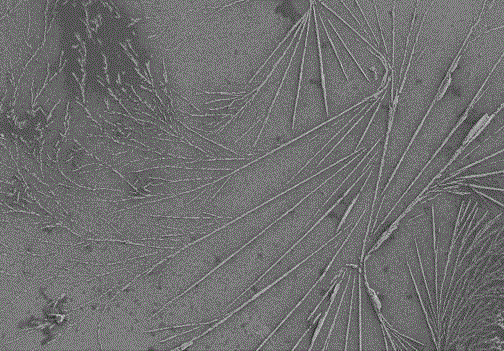Preparation method for anionic dicarboxy cellulose green flocculation material
An anionic and cellulose technology, applied in the field of environmental engineering, can solve the problems of raw material dependence on petroleum resources, difficulty in biodegradation, and low flocculation efficiency, and achieve the effects of increasing aldehyde content, enhancing electronegativity, and requiring less production equipment
- Summary
- Abstract
- Description
- Claims
- Application Information
AI Technical Summary
Problems solved by technology
Method used
Image
Examples
Embodiment 1
[0025] 1) Add 1g of reed pulp to the mixed solution of potassium hydroxide and urea that has been pre-cooled at 2°C for 20 minutes. The mass fractions of potassium hydroxide and urea are 5wt% and 10wt% respectively. The mass ratio of the pulp is 25:1, stirred for 4 minutes to disperse evenly, frozen at -10°C for 120 minutes, taken out and stirred in an ice bath to obtain a uniform and transparent cellulose solution;
[0026] 2) Heat the cellulose solution obtained in step 1) to 50°C under stirring, add anionization reagent sodium chloroacetate to react for 180 minutes, the mass ratio of sodium chloroacetate to reed pulp is 5:1, and obtain uniform, transparent, water-soluble Good anionic cellulose solution;
[0027] 3) Precipitating the anionic cellulose solution obtained in step 2) with ethanol, centrifuging, washing the solid until neutral, and obtaining anionic cellulose;
[0028] 4) Add the anionic cellulose obtained in step 3) to 50 mL of distilled water, add the oxidant ...
Embodiment 2
[0032] 1) Add 1g of moso bamboo dissolving pulp to the mixed solution of potassium hydroxide and urea which has been pre-cooled at 2°C for 20 minutes. The mass fractions of potassium hydroxide and urea are 5wt% and 10wt% respectively. The mass ratio of the moso bamboo dissolving pulp is 35:1, stir for 4 minutes to disperse evenly, freeze at -10°C for 130 minutes, take it out and stir in an ice bath to obtain a uniform and transparent cellulose solution;
[0033] 2) Heat the cellulose solution obtained in step 1) to 45°C under stirring, add anionization reagent sodium chloroacetate to react for 240 minutes, the mass ratio of sodium chloroacetate to moso bamboo dissolving pulp is 3:1, and a uniform, transparent, water-soluble Good anionic cellulose solution;
[0034] 3) Precipitating the anionic cellulose solution obtained in step 2) with ethanol, centrifuging, washing the solid until neutral, and obtaining anionic cellulose;
[0035] 4) Add the anionic cellulose obtained in st...
Embodiment 3
[0039]1) Add 1g of bagasse pulp to the mixed solution of potassium hydroxide and urea which has been pre-cooled at 2°C for 20 minutes. The mass fractions of potassium hydroxide and urea are 5wt% and 10wt% respectively. The mass ratio of the pulp is 45:1, stirred for 4 minutes to disperse evenly, frozen at -10°C for 140 minutes, taken out and stirred in an ice bath to obtain a uniform and transparent cellulose solution;
[0040] 2) Heat the cellulose solution obtained in step 1) to 55°C under stirring, add anionization reagent sodium chloroacetate to react for 420 minutes, the mass ratio of sodium chloroacetate to bagasse pulp is 8:1, and obtain uniform, transparent, water-soluble Good anionic cellulose solution;
[0041] 3) Precipitating the anionic cellulose solution obtained in step 2) with ethanol, centrifuging, washing the solid until neutral, and obtaining anionic cellulose;
[0042] 4) Add the anionic cellulose obtained in step 3) into 60mL of distilled water, add the o...
PUM
 Login to View More
Login to View More Abstract
Description
Claims
Application Information
 Login to View More
Login to View More - R&D
- Intellectual Property
- Life Sciences
- Materials
- Tech Scout
- Unparalleled Data Quality
- Higher Quality Content
- 60% Fewer Hallucinations
Browse by: Latest US Patents, China's latest patents, Technical Efficacy Thesaurus, Application Domain, Technology Topic, Popular Technical Reports.
© 2025 PatSnap. All rights reserved.Legal|Privacy policy|Modern Slavery Act Transparency Statement|Sitemap|About US| Contact US: help@patsnap.com



